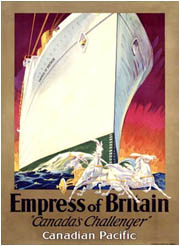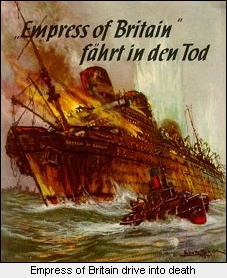Vol. 17 No. 7
July, 1987
|
Stay Safe in 87
|
|

Great "Empress"
Exuded Pride,
Grace, Dignity
|

Dave Jones
|
| |
 |
For many, the 1930's was a decade of diminished expectations. The stock market
crash of 1929, and the attendant economic depression which followed in its wake, left one in every five Canadians
jobless.
But for many others it was an era of rapid change and even adventure. Technological advances enabled more people to
make long distance phone calls, ride in new automobiles, and fly on transcontinental airplanes.
Into this tumultuous time, Canadian Pacific launched the steamship "Empress of Britain" on
11 Jun 1930. The 42,000-ton behemoth was the largest and fastest ship to ever fly the
famous CP checkered flag, and many who sailed on her claimed she was the most luxuriously appointed ship ever built.
Among her many attractions were two stages for theatrical performances, a motion picture theatre, an
olympic-size swimming pool, turkish baths, beauty parlors, a full-size tennis court on a
sports deck and public rooms designed and decorated by prominent members of the Royal Academy.
While 1,100 passengers in first, tourist, and third class could be accommodated with ease, few who set foot on her
decks were unimpressed by the spaciousness of her rooms and passageways, which set the Empress apart from her rivals
on the North Atlantic.
The maiden voyage from Cherbourg, France, to Quebec set a record of five days and 30 minutes, truly reducing the
Atlantic to "pond" status when compared to the 106-day voyage of the Mayflower, more than 430
years earlier.
LUMINARIES ABOARD FOR HISTORIC CROSSING
Among the luminaries aboard for the historic crossing were, Sir Edward Beatty, CPR president and driving force behind
the company's post-First World War shipbuilding program; Lady Mount Stephen, wife of founding president
George Stephen; and movie stars Douglas Fairbanks and Mary Pickford.
Upon their arrival in Quebec, Fairbanks voiced two objections to the ship: "the voyage was too short
because of the many attractions the ship offered; and the second was that these same attractions robbed one of the
sense of being on an ocean voyage".
The route down the sheltered St. Lawrence River was advertised as 39 percent less ocean than the route to New York
sailed by the "Mauretania" and "Aquitania", the Cunard line's rivals to the "Empress of
Britain". Throughout the media, the "Empress" was characterized as "Canada's Challenger" and
"The World's Wondership".
A new pier was constructed at Wolfe's cove in Quebec City to handle the oversized steamship, and news of every
arrival was flashed across the country.
When the "Empress" docked at Quebec on 1 Jun 1931, the Montreal Star reported that the noise
from her whistle caused a team of horses to run away in Alberta, 2,400 kilometres away. Canadian Pacific broadcast
the event of the steamer's arrival over its system and the team became frightened at the queer noise eminating from
the radio.
While the "Empress of Britain" was a worthy competitor in the transatlantic sweepstakes, she played her
starring role on the company's annual world cruise.
Making an appearance at 33 foreign posts in 21 different countries, the ship's arrival was often accorded front page
prominence, nudging Canadian Pacific's reputation to the forefront in transportation circles and laying to rest
Canada's image as a colonial nation.
A worldwide radio-telephone service made it possible for a businessman in Chicago to reach his family
aboard the "Empress" in less than 15 minutes on each Sunday during their 130-day voyage.
AMERICANS IMPRESSED BY EMPRESS' GRANDEUR
Even the Americans were impressed by her grandeur when 60 centimetres of her 63-metre mast tops were
lopped off to ensure she would pass under the newly-constructed Golden Gate bridge in San Francisco
without snagging the safety nets hung below.
In 1939, the "Empress of Britain" was chosen to ferry HM King George VI and Queen Elizabeth home from
their tour of Canada.
On 3 Sep 1939, war was declared with Germany, and the ship's bright white paint scheme was soon
replaced by the dull grey of a troopship.
 It was in this role, on 25 Oct 1940, while carrying 224 military personnel and their families, that she
ran out of luck on the northwest coast of Ireland.
It was in this role, on 25 Oct 1940, while carrying 224 military personnel and their families, that she
ran out of luck on the northwest coast of Ireland.
An enemy bomber rendered the "Empress" dead in the water, and the order to abandon ship was given.
Two days later, the German submarine U-32 delivered the coup de grace, sending the veteran of 100
round trips on the North Atlantic and eight round-the-world cruises to a watery
grave.
This CP Rail News article is copyright
1987 by the Canadian Pacific Railway and is reprinted here with
their permission. All photographs, logos, and trademarks are the property of the Canadian Pacific Railway
Company.
|